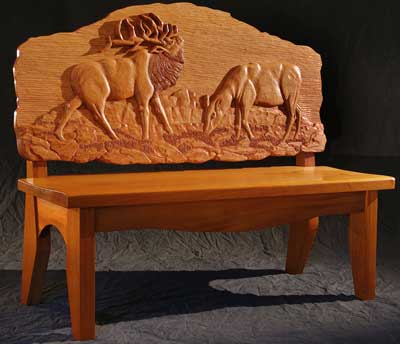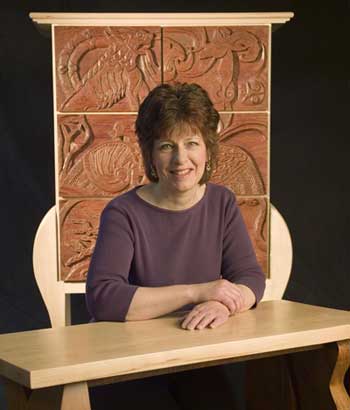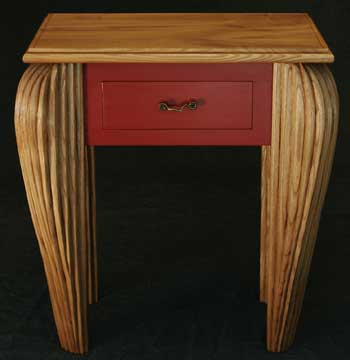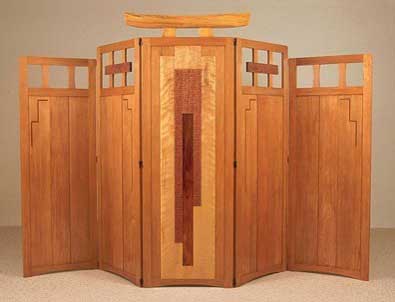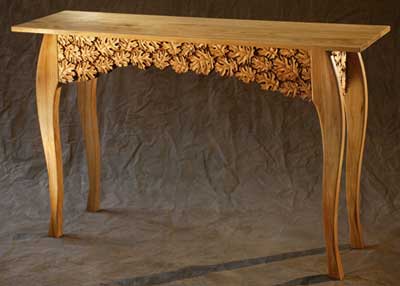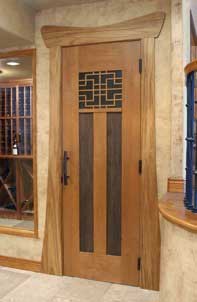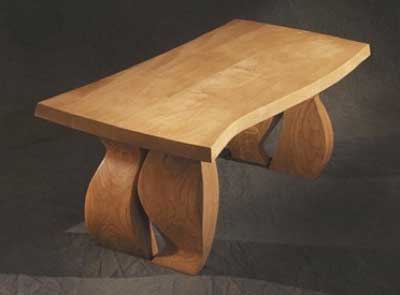
Pat Morrow had been a photographer for the Kansas City Star Sunday Magazine, a painting major in college, and a producer/director in Chicago before the idea occurred to her to become a woodworker.
She had moved to Colorado in search of a different adventure in life, thinking she would pursue her art in some form – at the time, she suspected the form would be tapestry weaving. Instead, as she and a glassblowing neighbor were brainstorming one day, the neighbor mentioned furniture making.
“It made a ton of sense,” Pat said. She decided to see if she could design something, and spent an afternoon sketching ideas. “They just poured out, and I thought they were good ideas. They still are.”
Among her early commissioned works, Pat said, she particularly liked the direction the designs for her “Henry” and “Elk” benches went in: an emphasis on shapes and forms in the Henry bench and the design of the legs for the Elk bench. Focus on shapes, form, color and texture is now part of what she sees as characteristic of her work.
After building the Henry bench, “I looked at my paintings from college,” Pat said. “I had not looked at them for maybe 25 years. What’s interesting is the things I was focusing on then in painting: shape and form and color. I thought it was interesting that it was something that made sense to focus on in my furniture.”
At first, Pat had thought that her role in creating wooden furniture would come in the design and the finishing. Then she “came upon a group of guys building a shop five minutes from my house, and they said, ‘Why don’t you just jump in and build it yourself?’”
So, she did. She jumped into woodworking classes at Red Rocks Community College in Denver after having a blast at the first one she attended, and found support through the Women In Woodworking.comwebsite and the Colorado Women’s Woodworking Guild.
Showing her student work at a local studio tour resulted in Pat’s first commission — with more to follow. These days, her work has been featured in Lark Books’ 500 Tables, Fine Woodworking’s Design Book Eight, and Schiffer Publishing’s Studio Furniture, and her pieces are in several homes. Designing them to work with those homes is one of the aspects of furniture building that Pat particularly enjoys.
“All my adult life, when I’ve moved into a new place, I’ve completely redone and redecorated it, even if it was an apartment. I love interior design and such, but it’s not what I was trained to do. Furniture design appealed to me because it really fit with what I loved to do.”
For example, one of her first commissions was for a large, Asian style screen. The room it was meant for was “very busy,” Pat said, with furniture from all over the world. Her wood selection, however, picked up the main color from the room’s molding and doors, with accents of rosewood on the side with a rosewood desk and mahogany on the side facing mahogany tables. “The woods picked fit all the furniture surrounding it, and it worked beautifully. It calmed the entire room down.”
As in that example, Pat said, she picks appropriate wood for each piece. “I don’t want the wood to be the thing of the piece. I love wood because of how you can work with it and its natural beauty, but I don’t want a piece to be about a particular wood. I’d rather it be about the design and the texture.”
That said, Pat does have a favorite wood to carve – genuine Honduran mahogany – but it’s getting too expensive to use. She enjoys carving, preferring to use it to create textures. In fact, carving was the first area of woodworking she explored.
She borrowed a friend’s carving tools – “something a child would use” – picked up some wood from outside her home, and began playing. She liked it enough that she ended up getting a couple of good gouges, a bench and a mallet. Those first woodworking tools became the foundation for the other equipment she’s now acquired to outfit her garage shop.
“You just start, and see where it takes you,” Pat said of carving. She also cited another of her favorite carved pieces: a wine cellar door. She had read a book by an early 20th century philosopher and architect which discussed the importance of doors as a threshold, going from one space into another.
“It got me thinking about doors. We take the frame for granted,” Pat said. “The door is the decorative part, the framework is just the structure. If you change the frame, it completely changes the structure.”
Right now, Pat’s working on a dining room table for a commission – and, at some point, some furniture for herself. Right now, she doesn’t own any of her own furniture. “It’s a different exercise to make something for myself, because I like so many things,” she said. “With each new piece, I try to bring forward what I’ve done previously, and make it a better design.
